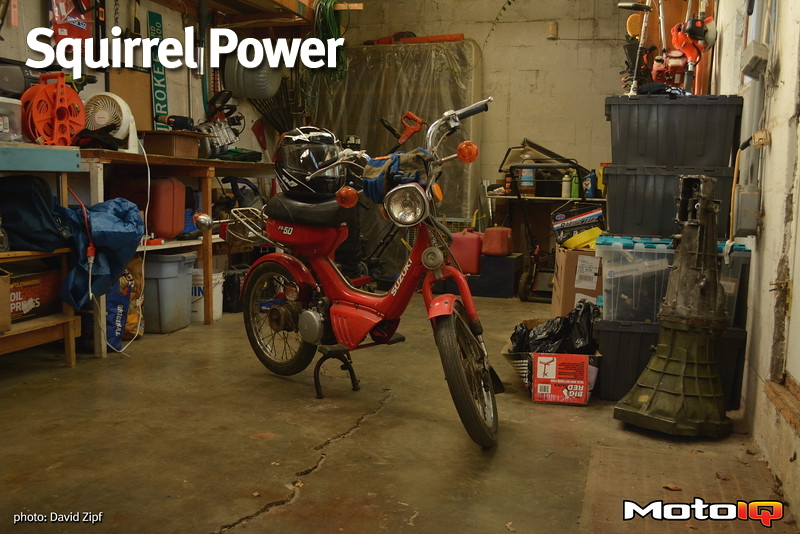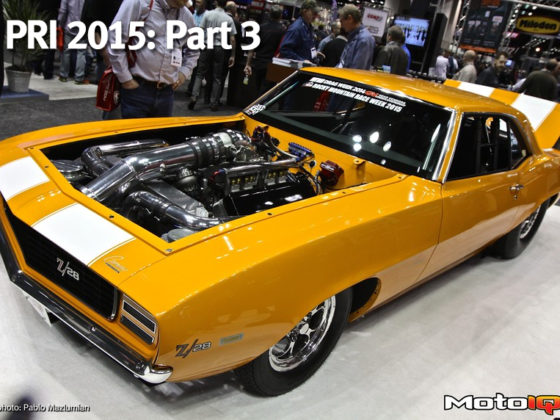,
 Pulling the oil tank is easy, but make sure you drain all the oil out first or it will make a hellacious mess (just yank the feed line to the oil pump and let gravity do the rest). You can see the level of old oil that was in the tank from where it has stained the plastic. You can also see all the farmyard crud from sitting in a barn for over a decade. All of this was cleaned off.
Pulling the oil tank is easy, but make sure you drain all the oil out first or it will make a hellacious mess (just yank the feed line to the oil pump and let gravity do the rest). You can see the level of old oil that was in the tank from where it has stained the plastic. You can also see all the farmyard crud from sitting in a barn for over a decade. All of this was cleaned off.With all the old fluids drained, we carefully pulled the carb and yanked the bowl. The bowl had some varnish and evidence of old oil, so we cleaned out as much of the staining as we could. The float moved freely, which was great news. Oil sludge can sometimes clog the float pivot and make the float stick, potentially flooding the carb and causing a fire! We also pulled each jet and cleaned them with carb spray and a couple strands from a scrap of wire. The jets are tiny and the oil muck doesn’t always come out with spray alone. We also cleaned the carb body before bolting it all back together.
 The floats were gross, but moved freely. Above them, lots of varnish and corrosion from old fuel remained.
The floats were gross, but moved freely. Above them, lots of varnish and corrosion from old fuel remained.  The bowl was varnished and a bit oily, but nothing too severe. At first we tried some carb cleaner and scrubbing, but the goo was pretty well stuck in there. This would take more drastic measures to fix…
The bowl was varnished and a bit oily, but nothing too severe. At first we tried some carb cleaner and scrubbing, but the goo was pretty well stuck in there. This would take more drastic measures to fix…
If you’ve never played with a carb before, these are the jets. They are tiny, so don’t drop them! The longer one is the idle jet (which fuels the engine at low RPMs), and the shorter, fatter one is the main jet (adding fuel at higher RPMs). Lots of FA50s that have sat for a long time suffer from poor idling, most often attributed to a clogged idle jet. Given its size, you can see why this is so often the case. Between old oil and aluminum oxide corrosion caused by ethanol fuels, cleaning carburetors should be part of the annual maintenance ritual for any old moped owner.
 The Mikuni carb uses a slide throttle instead of the more common butterfly. An important tip when reinstalling the carb is to smear a bit of oil on the barrel and its cylinder. The engine oil doesn’t really get up here and if these parts are not properly lubricated, the throttle will stick.
The Mikuni carb uses a slide throttle instead of the more common butterfly. An important tip when reinstalling the carb is to smear a bit of oil on the barrel and its cylinder. The engine oil doesn’t really get up here and if these parts are not properly lubricated, the throttle will stick. With the fuel and oil systems taken care of, we moved to the electrics. We pulled the spark plug and grounded it to check for spark and found none. The first thing we tried was replacing the spark plug as the original one was very old and caked with crud. This did nothing, so we pulled out the multimeter and began hunting lost electrons. The nice thing about a bike this simple and old is that all the electrics can be checked with a standard multimeter (also there’s about 8 wires in the entire wiring harness). We started at the ignition switch and found it worked perfectly. Next, we moved to the ignition coil. It too passed its checks. We pulled the magneto cover and checked the wiring for continuity: the harness was perfect, as was the rectifier. The only other culprit was the PEI unit, and those never fail, right?
 The original NGK plug was pretty gross, so we swapped it for a new Autolite plug. The NGK can be tough to find, but nearly every plug manufacturer makes an equivalent, so sourcing one at a parts store is easy. Even with this new plug, we still weren't getting spark.
The original NGK plug was pretty gross, so we swapped it for a new Autolite plug. The NGK can be tough to find, but nearly every plug manufacturer makes an equivalent, so sourcing one at a parts store is easy. Even with this new plug, we still weren't getting spark.



29 comments
Lol!! I bought one in ’98, still have it, and it still brings a smile to my face. I have upgraded since but it’s still fun to run around town.
I had one in high school back in 82-84. My dad got it for me when I asked for a car. It broke the ice quite well, but was not very useful for dates. Still had a lot of fun with it. Drove it to school my jr and sr year, as well as going to the hang out pizza place with friends. Lots of good memories. I actually got mine to hit 40mph a couple of times, but that was going down a pretty steep hill. Most of the time I topped out at around 30mph.
I have a fz50 very similar. The headlight is close enough to a 6v led flash light head, one of the ones that use the big square 6v battery. While the light pattern isn’t ideal it’s still a load brighter than factory
I just bought an FA50 as a project. Thanks for the story and the insights. I am really looking forward to the rebuild and perhaps some customization of mine.
Did you ever end up fixing it up? I just found one and wanna do the same thing but I don’t really know where to start.
Hey Alex! You ever get started? I’m a newbie in the midst of restoring one too and would love to chat
I’m in KY and looking for an FA50- still got this one or know of any others around? Had one in the 80s and looooved it!
6063562289
I actually bought a second last year with a dead engine. Been slowly rebuilding it (you’ll see more on that project at a later date).
I have a 1980 runs perfect looks great needs headlight. $500.00
Is FA50 still for sale? Just saw your post
I have one i just got its all. Original it’s a 19 89 Suzuki fa50 MDZ start on first kick runs excellent very excellent shape I’ll decals paint chrome rims everything is original just like it came up for the showroom asking 600 for it
Do you still have this available?
Aren’t the tires 12 inch not 14?
I have an FZ 50 that needs ‘em!
I have a 1983 Suzuki FA 50 I’m looking for some parts not sure if I can use a fly wheel off any 49 cc to a 50 cc flywheel ??
I meant 13 inch wheels. I have the cast iron rims, without spokes.
I am looking for a carb for FA50. I can’t find a part number and the one I found on the internet is soldout.
Do you have a part number for the replacement you used?
” The new carb is a Chinese knockoff and it shows: there is casting flash all over the body, which is clearly made of an inferior alloy, and the float inside is plastic. Installing the new carb means replacing the throttle and choke cable ends, which are both sized differently. Fortunately, the new carb includes both. “
I bought my carb on eBay, but Treatland sells them now. Treatland also sells larger carbs and accompanying intakes if you’re looking for more power.
i noticed that you didnt have a muffler, i just bought an ’84 FA50 without a muffler and i dont know wether any muffler off ebay or amazon will work or if i even need one. could you help me out?
You can ride your FA50 with no exhaust, but it will make your ears ring after a few miles. I already tried making my own exhaust for this FA50 and it was a failure. You can find used exhausts on eBay for ~$60, but most of them are rusted to death and clogged with 2-stroke soot. I would recommend getting an MLM exhaust from Treatland. MLM has three different exhaust options for the FA50. They’re all brand new and bolt in. They have an OEM replacement exhaust as well as a couple of performance options. If you’re doing a straight restoration, the OEM exhaust is the cheapest. But if you want a little extra power, the side bleed exhaust works on just about an FA50 build. I have one for this FA50, but have not written up the installation or review yet. I tried it on the stock engine and it made a noticeable improvement in mid range torque. I am currently running it on a 60cc engine I just finished up late in the Fall and it is a necessity to make that engine sing.
Great wrìte up! Thank you,
Does anyone have a diagram for the chaindrive. I opened up the case and the gears fell out.
You can find it in the factory service manual. Just search online and you’ll find a PDF scan of the entire Suzuki manual. It will also show you how the kick starter is laid out and it’s really important to assemble it correctly. If you don’t, the kick starter will shred itself.
Can anyone send me a link to the exact mikuni replacement carburetor that comes withThe throttle and choke ends as well as the intake gasket.
Please and thank you
https://www.treatland.tv/suzuki-FA50-stock-clone-carb-p/fa50-clone-carb.htm
Forgot the intake gasket:
https://www.treatland.tv/PRO-SERIES-suzuki-FA50-intake-gasket-p/suzuki-fa50-intake-gasket-grey.htm
Louisville, or Lex? I’m in Louisville. I rode all the way up to central Indiana to get a 80 Garelli SSXL, that been sitting in a warehouse for thirty years. I’m planning on an engine swap for that bad boy. I hope that fa50 done you well.
Lexington when this was written, but I’ve moved back to the East Coast since then. It’s a great little bike except when I forget to air up the tires and cut an inner tube! Got more to come for this little guy too
You can solder the float and keep your Mikuni carb over the cheap Chinese replacement
The knockoff was a temporary fix:
https://motoiq.com/squirrel-power-making-a-minibear-part-1/